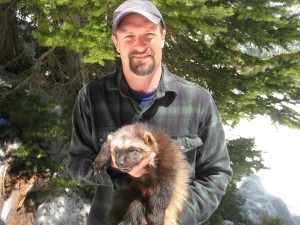Wolverine research moves toward management strategies
CODY, WYO. -- What breeds every other year, claims 300 square miles of terrain, lives at 9,000 feet elevation in harsh winter conditions, and fends off grizzly bears for scraps of spoiled meat?
The Gulo gulo, or wolverine, of course.
It sounds like the makings of a riddle, but eight years ago, as a team of biologists set out to study the wolverine, they were hard pressed to answer even basic questions surrounding the elusive animal.
With some pushing to list the wolverine as a threatened or endangered species, the lack of data was troubling. Even if the wolverine was listed for protection, no one at the time knew how to conserve the species.
"We needed the basic biological information so, if listed or not, we know what to do and what's important," said Bob Inman, director of the Greater Yellowstone Wolverine Program for the Wildlife Conservation Society."Our job was to go out and capture these animals. We needed to radio-track them to find out where they went, how they lived, how they bred, what they ate, how they died and when they reproduced."
Their eight-year field effort to study the wolverine wrapped up this winter with the first of several articles appearing in the Journal of Wildlife Management.The results, compiled in cooperation with Montana Fish, Wildlife and Parks, Wyoming Game and Fish and the U.S. Forest Service, among others, have already helped biologists better understand the resourceful animal.
Now the study will shift gears as wildlife managers in several states begin building conservation strategies to maintain the nation's small wolverine population and protect it from future challenges, Inman said.
Slow reproduction
Tracking what Steve Cain of the National Park Service described as "the winter endurance athlete of the animal world" wasn't easy.The team of biologists entered the snowbound terrain surrounding Yellowstone National Park to find the dogged wolverine.They climbed to elevations over 9,000 feet to capture and collar 30 animals with radio-tracking devices. What they witnessed over the next few years surpassed their wildest expectations.
"Wolverines have an incredible ability to move," Inman said. "They're only 25 to 30 pounds, but they're using a home range -- a territory -- that's 300 square miles. Even a grizzly uses a smaller area than they do."
The wolverine has adapted to make the best of its harsh alpine conditions, though survival isn't easy, even for the well prepared.Two wolverines were killed in avalanches during the study, Inman noted. Another wolverine challenged a bear 10 times its size for rights to an elk carcass.
"In order to pool together the resources they need, they have to cover a lot of ground to get by in those environments," Inman said. "As a result, they naturally exist in low numbers and they reproduce slowly."Wolverines live 12 to 14 years on average and females don't start reproducing until age 4. They produce just one or two cubs every other year.
The young are typically born in late February and early March, emerging into a harsh, cold world.
"They're these tiny young that don't weight half a pound, born at 9,000 feet in avalanche chutes with freezing temperatures and snow covering the den site," Inman said. "That's pretty rugged, but it fits the wolverine's reputation."
Small population
Wolverines enjoyed a historic range up and down the Rocky Mountains and thrived at high elevations in Washington state and the Sierra Nevada Mountains in California.But by around 1930, Inman said, the wolverine was nearly eliminated from the lower 48 states. He blames unregulated trapping and the poisoning of predators for the animal's near demise.
Over the last half-century, scientists have noted the wolverine's slow return from Canada. The animal has begun to reoccupy its historic range in Montana and parts of Idaho and Wyoming.One animal travelled more than 500 miles from Grand Teton Nation Park to Rocky Mountain National Park. It was the first wolverine documented in Colorado in nearly 100 years.
Inman estimates that around 250 wolverines now occupy a handful of island mountain ranges, most of them in Montana, Wyoming and Idaho. They depend upon snow cover at high elevations to survive."They're in all the places we expect them to be in Montana," Inman said. "We assume they're in Idaho as well, though no one has looked to see if they're there or not."
Scientists also have documented wolverines high in Wyoming's Wind River Range, along with the Washakie and North Absaroka wilderness areas surrounding Yellowstone Park.
There's a line somewhere in Wyoming where they are and where they're not," Inman said. "We're not real clear on exactly where that is."
The study, which wrapped up this winter, tracked the wolverines across multiple jurisdictions, with acomplex mix of land ownership and management authorities.Conservation of wolverines, the study suggests, will require coordinated efforts across the Western United States to aid in survival, reproduction and gene flow between isolated populations of animals."This is an animal that has to leave one island of high mountain habitat and cross valley bottoms to get to another one," Inman said. "Connectivity between these mountain ranges can be an issue."
Authors of the research paper include the Wildlife Conservation Society, Colorado State University and the Swedish University of Agricultural Science.The U.S. Forest Service, Montana Fish Wildlife and Parks, the National Park Service, Wyoming Game and Fish and the United States Fish and Wildlife Service also contributed to the project."We started with the field work and now we're moving to the stage of trying to do something with the information," Inman said. "We need to work with willing landowners and interact with land managers."



No comments:
Post a Comment